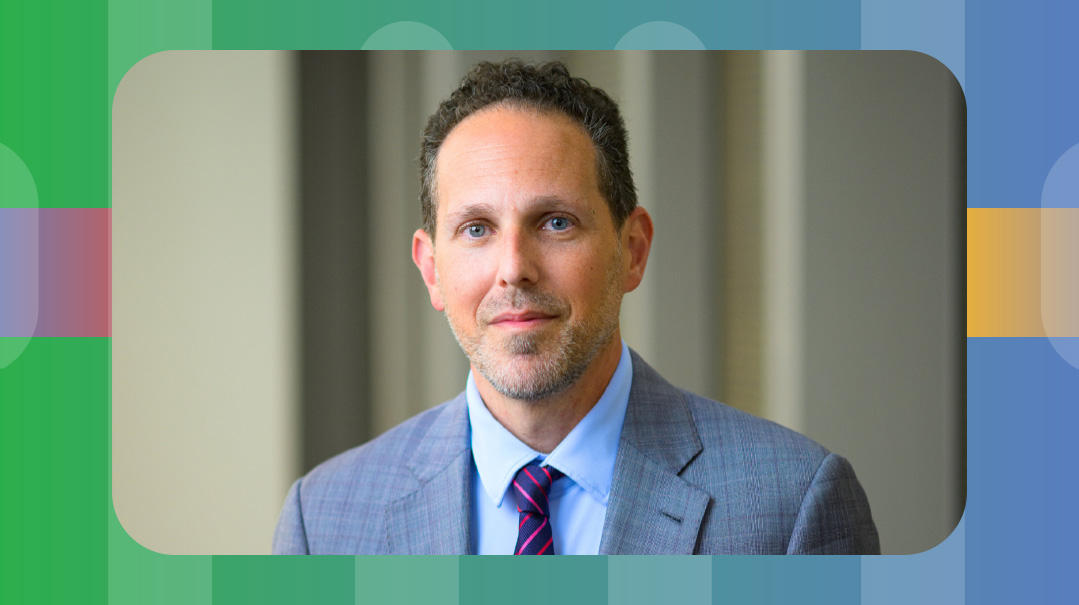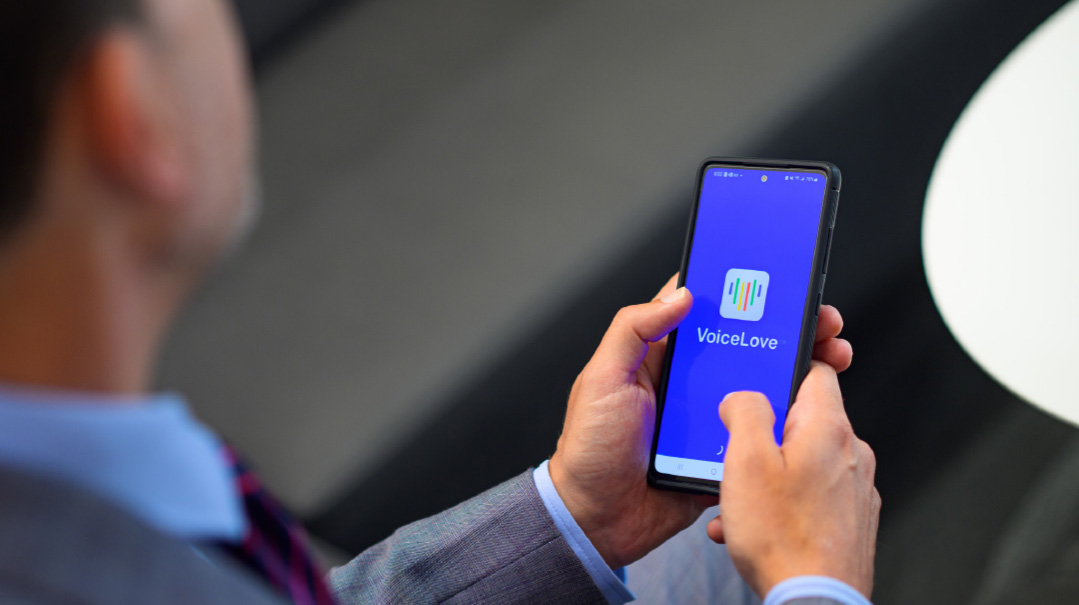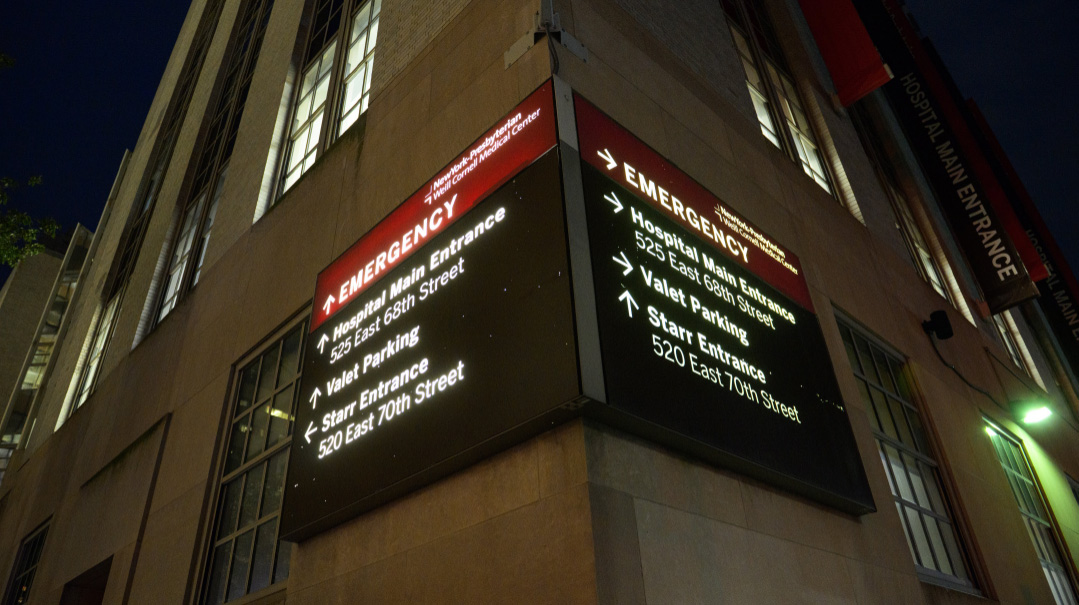To Hear Your Voice

Dr. Marc Schiffman connects isolated patients with worried loved ones

Photos: Naftoli Goldgrab
When Dr. Marc Schiffman started medical school at SUNY Upstate Medical University decades ago, he was eager to fuse his natural empathy and his analytic, scientific proclivity to heal patients in need. He never dreamed, though, that one day he’d pair his medical work with a tech startup… but then again, COVID-19 shifted many medical practitioners out of their comfort zones. And confronted with the desperation that the pandemic engendered in so many patients and their families, Dr. Schiffman knew he had to take action.
When a new, mysterious virus called COVID-19 reared its head in March 2020, Weill Cornell Medicine found itself inundated with patients in critical condition. While his specialty was interventional radiology, the pandemic called for all hands on deck, and together with other colleagues, Dr. Schiffman volunteered to pivot to intensive care and do what he could to support the beleaguered ICU staff.
The day he agreed to report for duty, a contingent of volunteer ICU doctors came in from California and areas in upstate New York where the pandemic hadn’t yet hit in order to bolster the ICU staff. Dr. Schiffman and his colleagues were now no longer needed in the ICU, but they still stood ready to serve. Aiming to identify the most vital need, Dr. Schiffman took note of the patients who were kept in isolation because of safety concerns, yet realized that the medical personnel working harrowing shifts in a chaotic environment weren’t up to the task of trying to keep patients’ families updated. Frantic family members were home worrying and praying, with no way to reach out to their loved ones.
Dr. Schiffman and his colleagues recruited other doctors, all of whom would accompany the ICU doctors on their morning rounds and then break away and spend the remainder of their day calling patients’ families and supplying them with consistent daily communication.
“Every single family member we spoke to was desperate,” he recalls. “Almost all asked us to hold the phone up next to their family member’s ear so they could hear their voice. It was heartbreaking.”
While engaged in his mission, Dr. Schiffman consistently saw how patients who connected with loved ones, even if only by voice, felt noticeable relief — not only emotionally but physically. Blood pressure would stabilize, breathing would ease, and even comatose patients would respond in some way to the voices of their family members. Seeing the results on the ground, Dr. Schiffman and his colleague Dr. Tamatha Fenster were determined to find a solution to bring down the intolerable barrier Covid was erecting between patients and their families.
“Health care communication had always been a problem that had gone unaddressed,” he says, “and we decided we were going to fix that.”

Keeping Connected
Dr. Schiffman, whose professional titles include Co-Executive Director of The Weill Cornell Medicine Fibroid and Adenomyosis Center and Assistant Professor of Radiology at Weill Cornell Medical College/New York Presbyterian Hospital, says his background as an interventional radiologist prepared him to take on this new, ambitious endeavor. While diagnostic radiologists are doctors who specialize in diagnosing and treating illnesses and injuries using medical imaging such as X-rays, computed tomography (CT), magnetic resonance imaging (MRI), nuclear medicine, positron emission tomography (PET) and ultrasound, the interventional radiologist goes one step further and uses medical imaging to guide minimally invasive surgeries that diagnose, treat, and cure medical conditions.
“I was drawn to my field because a lot of what an interventional radiologist does is to treat patients where there is no textbook solution for their illness. They need someone to come up with one,” he says.
To identify the right solution for every patient’s needs, Dr. Schiffman must integrate processes from other disciplines and apply them forward. While it’s a challenging field, the catalyst that drives this innovative thinking is his empathy for people. “I’ll figure out something to help them,” he says.
Upon spending his days in the ICU, that natural compassion drove him to find a solution to connect patients to their families. In an unlikely, rather prosaic spin, he and his colleague Dr. Fenster found the solution in Target: An online search yielded a toy speaker that connected to an app. After the speaker would be set up near a patient’s bed and activated, family and friends could download the app and speak to the patient via their phones. Patients were often in compromised positions that didn’t allow them to use their own phones, but with the device they didn’t have to do anything except listen as their family’s voices were relayed over the speakers. Bolstered by the feedback, Dr. Schiffman drove out to Target and picked up all the speakers they had in stock.
Grateful families connected, talked, sang, prayed, and expressed their love and encouragement to their loved ones, while compromised patients, some comatose, others immobilized by ventilators, were able to hear and take heart. Things moved quickly from there. In short order, Dr. Schiffman arranged that the toy company would donate speakers to Weill Cornell patients, and they were distributed to over 150 families.”
As the virus continued its relentless spread, people from across the country who heard about Dr. Schiffman’s and Dr. Fenster’s initiative reached out to them with heartbreaking stories. “I haven’t heard about my loved one for a week. I don’t know if he’s alive or dead,” one person painfully shared. Dr. Schiffman responded by buying and shipping out toy speakers to anyone who requested one.
At the end of December, Dr. Schiffman’s work in the trenches took on a more intimate turn. His mother developed a fever, and, after a long stay in the ICU, passed away. Before Gail Schiffman became ill, her son would share his work with her and describe the help he was providing those who were suffering. After her passing, Dr. Schiffman decided to use the inheritance she’d left him to establish something in her honor that would change the health care system and help people around the world.
“She was so proud of the work we were doing, and I knew this would be a meaningful tribute to her,” he says. And that’s how VoiceLove, an innovative, interactive communication device designed to facilitate communication and improve patient care, was born.
Drs. Schiffman and Fenster developed VoiceLove as a voice messaging app that can be used on any smartphone or computer. Its goal is to facilitate communication in medical settings between patients, their loved ones, medical staff, and even clergy. Practically speaking, the device works as a more complex version of a walkie-talkie, with the patient listening on one end and family able to speak on the other. Patients who are conscious and well enough to respond can simply press a palpable large heart with minimal effort and be heard, too.
Dr. Schiffman knew that for the device to fill the connection gap for ill patients, he had to develop something that even a compromised patient could utilize independently. Even under normal conditions, ICU nurses are extremely busy. With the extenuating circumstances forced on them by the pandemic, they were far too strained to hold a phone up for a patient for an extended period. There was also the concern that sitting with a patient would introduce an increased risk of exposure to staff members, which has always been a safety issue that limits connection assistance for many patients.
Keeping all that in mind, the VoiceLove device was designed to offer maximal simplicity, with only one button that activates it. A blind or aged person can easily manipulate it, and, alternately, a nurse can quickly “press and go” before moving on to care for other patients.
Dr. Schiffman wanted the device to offer the option for multiple people to connect, so a patient’s whole shul, school or other community group could log in and send messages of hope. During Covid, the device allowed clergy members from all religions to log in and pray with patients. And, for purposes of privacy and protection, the device had to be HIPAA compliant and secure, so participants’ personal contact information would remain private and safe.

Never Alone Again
Ultimately, getting VoiceLove off the ground involved extensive planning and testing, unsurprising for a new technology being introduced into a medical setting. After initial interviews with software developers, Drs. Schiffman and Fenster immediately realized that the device had to be something that would be accessible to users from all over the world — an app as opposed to a product — like the Target model. It would need to be programmed so that it could be downloaded, with the option to accept updates. It could not depend on WiFi, like the toy walkie-talkies they had been distributing. WiFi, with its limited service, is inadequate at many hospitals around the country.
When the pandemic eased somewhat, Drs. Schiffman and Fenster met with the American Hospital Association multiple times to discuss how the prototype could meet the current and future hospital cybersecurity requirements. The hospitals, though, were initially wary, Dr. Schiffman says. They were being forced to adopt major technological shifts at a stunning pace, and they were overwhelmed. And, as security is always a primary concern in health care, the answer to any innovation is often a default no.
Dr. Schiffman recounts an unhappy instance during the height of Covid, when he shipped a speaker to a hospital and the patient’s whole family gathered around to speak into the app. But the hospital would not allow the device into the patient’s room, and the patient passed away without his family’s last words of support and final prayers.
Still, with all the medical world’s reluctance to introduce new technology, the challenges of the times demanded it. Zoom and other such models were being incorporated into the medical world with uncanny rapidity. Video medicine and telehealth remote treatment of patients became viable options. In Dr. Schiffman’s opinion, the extenuating circumstances Covid wrought led 20 years of innovation in health care to be compressed into months, which ultimately, changed medical practices forever. There was room for VoiceLove on the medical front.
After touring hospitals throughout the country, visiting ward after ward to assess patients’ needs, the doctors soon identified pockets of vulnerable patients in desperate need of additional attention and care. Elderly patients often lay alone. Blind patients, thrust into unfamiliar environments, needed assistance for basic needs. Non-English speakers were lost without a means of communication. Though the medical establishment may have been addressing their patients’ bodies, their minds and spirits were in pain.
“How,” asks Dr. Schiffman, “has this never been a concern on the forefront of health care, when you’re taking care of the sickest of people?”
Moving forward, when Dr. Schiffman reached out to researchers from all over the world and told them what he was working on, he was met with many enthusiastic responses. In late 2021, the device was piloted in Tennessee’s Vanderbilt University Medical Center with great success. The doctor who headed the pilot program told Dr. Schiffman that when he saw the device being used and realized what benefits it offered, he had an “Aha!” moment. “Why didn’t I think of that?” he said ruefully.

No Patient Left Behind
The plight of elderly patients in particular struck a personal chord in Dr. Schiffman. When his mother had been ill, he had free access to visit her because she was hospitalized in Weill Cornell. However, he found that when he left her side, the nurses would call him soon after to report that she had become confused and agitated. He says that delirium in elderly patients is often an unfortunate byproduct of an extended hospital stay. To compound the problem, health care workers often resort to treating agitated patients with sedation, which worsens delirium and harms the patients in the long term.
Dr. Schiffman approached the National Institute on Aging and applied for a grant to develop VoiceLove, with the goal of seeing how it could benefit the aging population. The study would explore if increasing the connection between elderly patients and their family and friends throughout hospitalizations would help prevent confusion and delirium, and speed the recovery when delirium presents.
Dr. Schiffman points out that patients suffering from confusion and delirium actually cost hospitals a great deal of money. Delirium leads to longer hospitalizations, longer ICU stays, more intubations and falls, and the comorbid illnesses that develop with longer hospital stays. In addition, after patients develop early dementia and leave the hospital, they generally experience more readmissions than they otherwise would.
Sadly, many elderly patients are admitted with their mental faculties intact, but then develop dementia or Alzheimer’s in the hospital and are unable to return to independent living. And the longer a patient suffers from delirium, the more likely he is to develop dementia, if it is not aggressively stopped or reversed. Dr. Schiffman shares a sobering statistic. He says studies show that mortality rates go up 10 percent every day that a patient is left untreated for delirium.
Ultimately, VoiceLove received a $3 million grant from the National Institute on Aging on the day of his mother’s passing. Phase 1 and Phase 2 of the project’s research development were fast-tracked, and the device came to fruition a year after her death.
Why the name? “VoiceLove named itself,” Dr. Schiffman says. “We heard the love that poured through the speakers as whole families would gather and get on, taking turns talking, praying, and singing their love.”
Today, VoiceLove is up and running, available to hospitals, nursing homes, hospices and other health care facilities to onboard. Innumerable modifications have been made through the real-world experience during the pilot programs, and improvements continue to be made in anticipation of the full launch this summer. Patients can be provided with a VoiceLove phone, creatively nestled in a protective case with an enlarged, heart-shaped “talk” button that broadcasts audio messages as they are received, while still respecting sleep cycles and procedures being performed. The case is affixed to a hospital bed, while facility staff manages all codes and settings from a dashboard interface.
Each device gets its own secure channel code and can be accessed by any number of people the patient or their health care proxy chooses. The device records families’ messages as voice notes and will arrange them in order if several people are talking at once. These messages can be replayed, so if a confused patient needs to be reoriented, a voice message from their child or parent can be repeated to calm or refocus them. Patients across the US have received voice notes and prayers from as far away as France, Senegal, Nigeria, Germany, London, and Israel.
Some patients choose to include their whole shul on the app and can daven with them from afar. The VoiceLove developers have even made it possible for celebrities and sports figures to send messages to sick children who need a pick-me-up. Celebrities can easily download the app, access the child’s channel, and talk to him from their personal cell phones without revealing their personal contact information and jeopardizing their privacy or security.
Up next for VoiceLove is its application in the neonatal intensive care unit (NICU), the military, and in hospice units. Dr. Schiffman is in the process of applying for a grant from Vanderbilt University for another $3 million to study the benefits that VoiceLove may yield for mothers and infants and has received preliminary notice of a positive response. Mothers of premature or ill infants often aren’t able to stay in the hospital round the clock, and it can be heart-wrenching for them to leave their fragile little ones behind daily, or upon returning to work when their maternity leaves are up.
Mothers with infants in the NICU are at increased risk of postpartum depression, anxiety, and psychosis. However, Dr. Schiffman says it’s been shown that when mothers are able to sing and interact with their infants that risk is considerably reduced. The app can be placed in the infant’s bassinet, and both the infant and the mother benefit from the connection. The babies display lower heart and respiratory rates; pain scores during procedures are reduced, and the mothers exhibit lowered rates of depression and improved milk production.
VoiceLove is currently seeking collaboration with the military to develop and research ways to benefit wounded soldiers far from home. Dr. Schiffman is also in contact with different facilities that tend to end-of-life issues to see if enhanced family communication will benefit hospice patients who do not live near their loved ones, or whose loved ones cannot stay at their bedside. With a little effort and innovative technology, Dr. Schiffman says, “No one ever has to die alone again.”
Ultimately, ensuring that patients experience as much love and connection as possible is not just a nice thing to do, it actually improves outcomes. And Dr. Schiffman’s passion is evident as he reiterates his goal: “I don’t want another family to suffer the way mine — and millions of other people — have been forced to until now. We will keep the heart and humanity in health care, and a new communication paradigm in medicine is here to stay.”
(Originally featured in Mishpacha, Issue 1003)
Oops! We could not locate your form.







